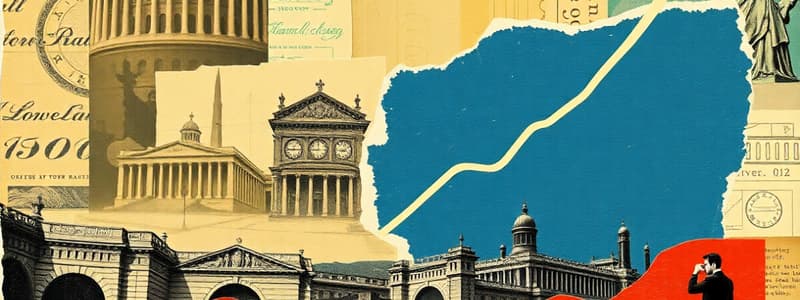Podcast
Questions and Answers
If the interest rate is zero, a promise to receive a $100 payment one year from now is?
If the interest rate is zero, a promise to receive a $100 payment one year from now is?
- Less valuable than receiving $100 today
- More valuable than receiving $100 today
- Equal in value to receiving $101 today
- Equal in value to receiving $100 today (correct)
Present value is higher when the future value of the payment is?
Present value is higher when the future value of the payment is?
- Lower, the time until payment is shorter, and the interest rate is higher
- Higher, the time until payment is shorter, and the interest rate is lower (correct)
- Higher, the time until payment is longer, and the interest rate is lower
- Lower, the time until payment is shorter, and the interest rate is higher
At a price of $400 in this market, which is true?
At a price of $400 in this market, which is true?
- There is an excess supply of bonds (correct)
- The market clears
- The bond market is in equilibrium
- There is an excess demand for bonds
How would the robust economic growth expected to last several years be reflected in the risk structure of interest rates?
How would the robust economic growth expected to last several years be reflected in the risk structure of interest rates?
When expected inflation increases, for any given nominal interest rate, what happens?
When expected inflation increases, for any given nominal interest rate, what happens?
Which one of the following would lead to an increase in bond supply?
Which one of the following would lead to an increase in bond supply?
Suppose that the expected return on bonds falls relative to other assets. In the bond market this will result in?
Suppose that the expected return on bonds falls relative to other assets. In the bond market this will result in?
Which one of the following statements about a deterioration in business conditions and a decrease in a nation's wealth is false?
Which one of the following statements about a deterioration in business conditions and a decrease in a nation's wealth is false?
Which of the following is true of interest-rate risk?
Which of the following is true of interest-rate risk?
How would expected interest rate increases by the Federal Reserve affect the bond market?
How would expected interest rate increases by the Federal Reserve affect the bond market?
If a bond's rating improves, we would expect?
If a bond's rating improves, we would expect?
Fatima holds a one-year $200 face value, taxable bond with a coupon rate of 5%. If her tax rate is 20%, how much tax will she pay for income earned on the investment? And what is the return on the investment when taxes are taken into account?
Fatima holds a one-year $200 face value, taxable bond with a coupon rate of 5%. If her tax rate is 20%, how much tax will she pay for income earned on the investment? And what is the return on the investment when taxes are taken into account?
Flashcards are hidden until you start studying
Study Notes
Interest Rates and Present Value
-
A promise to receive $100 in one year, when the interest rate is zero, is equal in value to receiving $100 today.
-
Present value is higher when the future value of the payment is higher, the time until payment is shorter, and the interest rate is lower.
Bond Market Supply and Demand
- The Demand and Supply equations for the bond market are:
- Demand: Qd = 1,000 – 6P/5
- Supply: Qs = P – 100
- At a price of $400, there would be an excess supply of bonds.
Economic Growth and Interest Rates
- A period of robust economic growth typically leads to an increase in the term spread, as investors become more optimistic about future economic prospects.
Inflation Expectations and Bond Yields
- When expected inflation increases, for any given nominal interest rate, the yield on bonds will increase.
Factors Affecting Bond Supply
- An increase in government spending relative to revenue can lead to an increase in bond supply.
Impact of Expected Returns on Bond Demand
- If expected return on bonds falls relative to other assets, the bond demand curve will shift to the left.
Business Conditions and Bond Market
- A deterioration in business conditions that also causes a decrease in a nation's wealth will lead to a leftward shift in both bond demand and bond supply.
- The impact on bond prices will be ambiguous since both the bond demand and supply curves shift left.
Interest-rate Risk
- Interest-rate risk refers to the risk that the market value of a bond will change due to fluctuations in interest rates.
- Individuals owning long-term bonds are exposed to greater interest-rate risk.
Federal Reserve Interest Rate Policy and the Bond Market
- If the Federal Reserve is expected to raise interest rates, this will likely lead to a decrease in bond prices and an increase in yields.
Long-Term Economic Growth and the Bond Market
- If an economy continues to grow at robust rates for a long period of time, the demand for bonds will likely increase, driving down yields and increasing bond prices.
Bond Ratings and Market Demand
- If a bond's rating improves, the demand for the bond will increase, and the yield will decrease.
Taxable Bond Returns
- Fatima will pay $4 in taxes on her bond investment.
- The return on the investment after taxes will be 4%.
Bond Yield to Maturity
- If a bond's yield to maturity is less than its coupon rate, the bond was likely purchased at a premium.
Studying That Suits You
Use AI to generate personalized quizzes and flashcards to suit your learning preferences.



